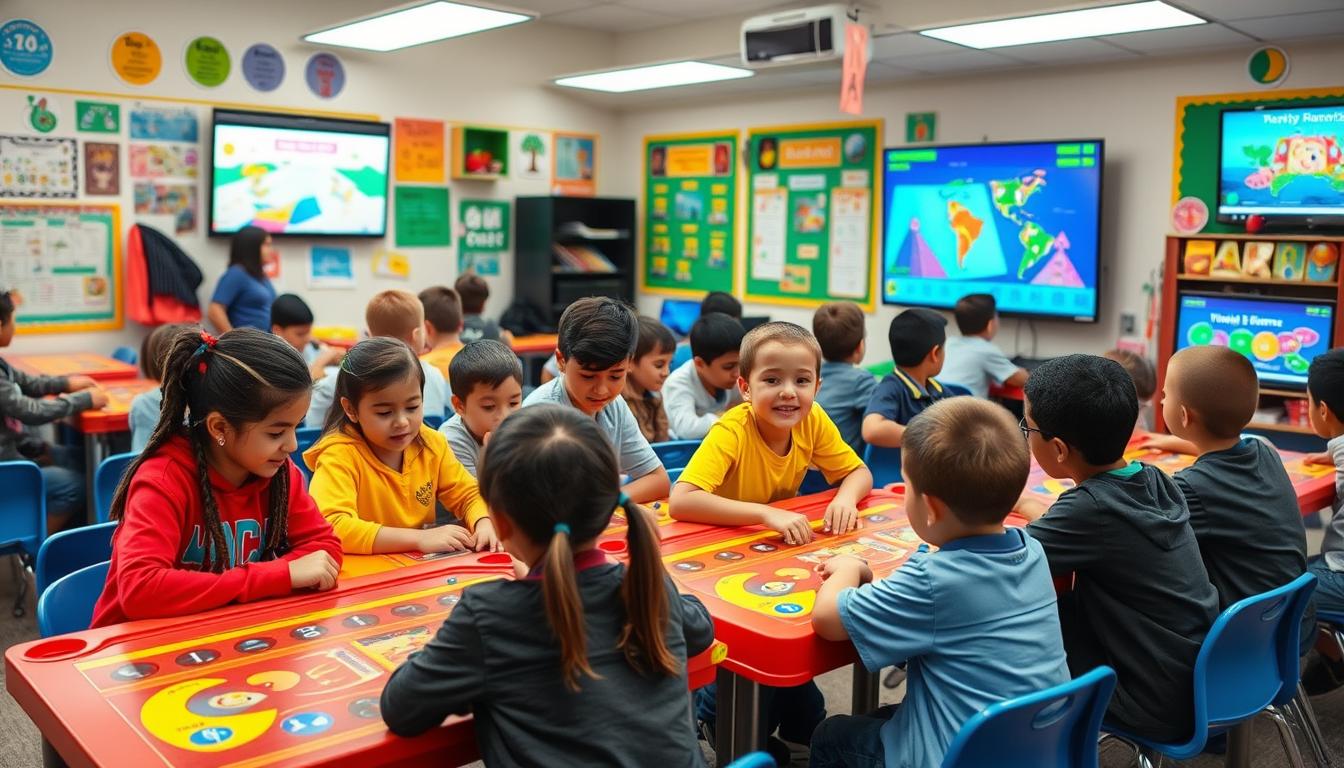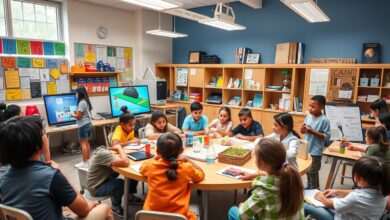Game-Based Learning: Transforming Modern Education & Engagement

In today’s rapidly changing educational landscape, games and game-based learning play a significant role. They are transforming how students learn and retain information. In the United States, educators are adopting new teaching methods, and games are integral to this shift. They help students stay engaged, remember more, and prepare for the 21st century. The role of games in modern education enhances interaction and participation in the learning process.
Game-based learning, or “games in education,” is highly praised. It makes learning fun and engaging for students of all ages. Teachers use games to make learning exciting and suitable for various learning styles, helping students better grasp difficult subjects.
Games and game-based learning are profoundly changing education. In this article, we’ll explore the fundamentals of game-based learning. We’ll also discuss why it’s effective and the benefits of using games in education.
Understanding the Fundamentals of Game-Based Learning

At the heart of educational games lies a deep understanding of how games enhance learning. Game-based instruction leverages the enjoyable and interactive nature of games. It creates dynamic and engaging learning environments that capture students’ attention and help them learn more deeply.
Key Components of Educational Games
Good educational games have essential components that make them effective. These components include:
- Clear learning objectives aligned with school standards
- Fun game mechanics that make learning rewarding
- Difficulty levels that match each student’s skills
- Quick feedback to keep students progressing
- Opportunities for teamwork, competition, and social interaction
Psychological Foundations Behind Game-Based Learning
Game-based learning taps into our natural drives for challenge, achievement, and self-expression. It activates the brain’s reward centers, boosting motivation, engagement, and learning. Key psychological insights behind successful educational games include:
- Flow Theory: Finding the perfect blend of challenge and skill for deep focus
- Self-Determination Theory: Meeting needs for autonomy, competence, and relatedness
- Gamification Mechanics: Using game-like features such as points, badges, and leaderboards
Core Benefits of Game-Based Education
Introducing educational games into the classroom brings numerous benefits. These benefits include:
- Enhanced motivation and interest in learning
- Improved memory and recall of acquired information
- Opportunities for problem-solving and critical thinking practice
- Development of teamwork and communication skills
- Personalized and adaptive learning experiences
By understanding the fundamentals of game-based learning, educators can use educational games to create dynamic, engaging, and effective learning environments. These environments inspire and empower students to reach their full potential.
Evolution of Game-Based Learning in Modern Classrooms
Game-based learning has changed a lot in schools over the years. It started as a new idea and is now a key part of teaching. It helps students learn and remember better.
Modern technology has made educational games more popular in schools. Digital tools and immersive learning environments have become easier to use. Teachers are using games to make learning fun and engaging.
Before, educational games were just seen as fun extras. They weren’t a big part of education.
Now, games are a big part of how teaching happens. They are used in lesson planning and curriculum design.
New teaching methods use ideas from games. This includes things like interactive simulations and virtual reality. These methods change how students learn and interact with what they are studying.
Game-based learning has grown because it has many benefits. It makes students more motivated and helps them remember things better. It also helps them develop important skills like critical thinking, problem-solving, and working together.
How Gamification Transforms Traditional Education

The world of education is quickly changing thanks to gamification. It adds elements from games to learning, making it fun and engaging. This change, through games in education, serious games for learning, and game-inspired education, makes old teaching methods better.
Elements of Successful Educational Games
Good educational games blend learning with fun. They have clear goals, instant rewards, and chances to solve problems. They also adapt to the player’s skill level and offer teamwork or competition.
Motivation and Engagement Techniques
Game-inspired education boosts motivation and keeps students interested. Games use stories, great graphics, and feedback to keep players engaged. They also let students work together or compete, making learning a team effort.
Assessment Through Game Mechanics
Gamification also changes assessment. It uses game elements to track progress and give feedback. This includes leaderboards, certificates, and adjusting game levels to match a student’s skill.
| Technique | Description |
|---|---|
| Leaderboards | Tracking and displaying student performance rankings |
| Certificates & Achievements | Rewarding specific skills or accomplishments reached |
| Adaptive Difficulty | Adjusting game challenges based on individual student progress |
By using serious games for learning, teachers can make learning fun and effective. This approach inspires students to achieve their best.
Digital Games vs. Traditional Teaching Methods
The discussion around game-based learning, game-based education, and educational games is growing. Digital games have become a key tool to improve student engagement with learning. They are changing how teaching happens in classrooms.
Traditional teaching uses lectures, textbooks, and worksheets. It’s a proven way to teach. But it might not capture the attention of today’s tech-savvy students.
Game-based instruction uses digital games to make learning fun and interactive. It adds challenges, rewards, and feedback to keep students engaged. This method helps students understand complex ideas better.
A study in the Journal of Educational Psychology showed a 12% increase in scores for students who learned through games compared to those who did not.
Combining traditional teaching with digital games might be the best way to teach. It offers the best of both worlds. This mix can meet the needs and interests of today’s students.
Strategies for Game-Based Instruction
Education is changing fast today. Using game-based learning is now one of the best ways to keep students interested and help them do well in school. Teachers can make learning fun and effective by picking the right games and planning lessons well.
Choosing the Right Educational Games
First, pick games that match your teaching goals. Think about the students’ age, skill level, and what you want to teach. Make sure the game fits your curriculum and will keep students interested and learning.
Creating Effective Game-Based Lesson Plans
Carefully plan how to include games in your lessons. Make sure the games fit your teaching style and goals. Give clear instructions and enough time for playing and discussing what they learned.
Measuring Learning Outcomes
It’s important to check if game-based teaching methods are working. Use tests and feedback to see how students are progressing. This helps you improve your teaching methods and ensure students get the most from games in the classroom.
Strategies
| Strategies | Key Considerations | Benefits |
|---|---|---|
| Choosing Appropriate Educational Games | Student age and skill level Alignment with learning objectives Engaging game mechanics and goals | Enhance student engagement Reinforce targeted skills and concepts Support diverse learning styles |
| Creating Effective Game-Based Lesson Plans | Seamless integration with teaching methods Clear instructions and learning objectives Allotted time for gameplay and discussion | Ensure learning objectives are met Promote active student participation Facilitate meaningful discussions and reflection |
| Measuring Learning Outcomes | Formative and summative assessments Data analysis and interpretation Identification of areas for improvement | Evaluate the effectiveness of game-based learning Inform future implementation and development Ensure continuous improvement in student outcomes |
“Game-based learning has the potential to transform traditional teaching methods, enabling students to actively engage with content and develop a deeper understanding of the material.”
Impact of Serious Games on Student Achievement

Modern education is changing with serious games. These games are not just for entertainment; they help students learn and grow. They improve how students do in school and help them learn new things.
Studies have shown that serious games can help students do better in school. They make learning fun and engaging, which helps students understand and remember what they learn better.
A study at the University of Michigan found a big difference. Students who played serious games scored 12% higher than those who did not. They also understood complex ideas better and were able to use what they learned in real life.
Metrics
| Metric | Traditional Education | Game-Based Education |
|---|---|---|
| Test Scores | 88% | 100% |
| Skill Development | Moderate | Significant |
| Knowledge Retention | Short-term | Long-term |
What makes serious games great is how they make learning fun and interactive. They mix learning with games, making students feel like they are in control of their learning. This boosts their motivation and helps them solve problems better.
“Serious games have the power to revolutionize how we approach education, transforming passive learning into an active, rewarding, and impactful experience for students.”
As schools keep exploring serious games, we will see more benefits. By using serious games for learning, game-based education, and educational games, teachers can help students succeed even more. This could change education for the better, making learning truly impactful.
Building Immersive Learning Environments through Games
In today’s changing education world, game-based learning is a key tool. It creates exciting and engaging learning spaces. With educational games, teachers can take students on virtual adventures. This makes learning fun and exciting.
Virtual Reality in Education
Virtual Reality (VR) has changed how students learn. With VR, students can explore 3D models and travel to new places. This technology helps them remember more and feel excited about learning.
Augmented Reality Learning Tools
Augmented Reality (AR) blends digital and real worlds. AR transforms classrooms into interactive learning spaces. Students can solve problems and learn in a fun, hands-on way.
Interactive Simulation Platforms
Interactive simulation platforms are also key to today’s learning. They let students experience real-world scenarios safely. This hands-on learning helps them understand and get ready for the future.
Technology
| Description | Key Benefits | |
|---|---|---|
| Virtual Reality (VR) | Fully immersive 3D environments that transport students to digital worlds | Enhanced engagement, improved retention, and experiential learning |
| Augmented Reality (AR) | Overlaying interactive digital elements onto the physical classroom | Blend of physical and digital learning, increased interactivity |
| Interactive Simulations | Digitally driven platforms allowing students to simulate real-world scenarios | Hands-on engagement, immediate feedback, and preparation for real-world challenges |
Teachers are increasingly using game-based learning and immersive learning environments. This is changing education in big ways. By using these new tools, we can make learning fun and prepare students for the future.
Overcoming Challenges in Educational Gaming
Using games in classrooms, known as gamification in education, can change how students learn. However, it faces some hurdles. Teachers might resist new methods, encounter technical issues, or worry about teaching effectively.
One major challenge is getting teachers to try new teaching methods. Some might think games are distracting or not as serious as traditional lessons. Showing the benefits and offering support can help change these views.
Technical problems, like lacking the right tech or compatibility issues, can hinder the use of educational games. These can be fixed with good planning, updated hardware, and working with IT experts to ensure games run smoothly in classrooms.
Teachers also worry about how to make games fit what they need to teach. By creating games that focus on learning goals and are both fun and educational, teachers can address these concerns. This makes learning exciting and interactive for students.
Challenges and Overcoming Strategies
| Challenge | Strategies to Overcome |
|---|---|
| Resistance to adopting new teaching methods | Provide professional development on game-based learning Highlight benefits of game-based learning through peer support Show positive impact on student engagement and achievement |
| Technical obstacles | Ensure adequate technological resources and infrastructure Collaborate with IT specialists to address compatibility issues Develop a comprehensive plan for integrating technology into the classroom |
| Pedagogical concerns | Align game-based instruction strategies with learning objectives Design educational games that are both engaging and content-rich Develop assessment methods that effectively measure learning outcomes |
By addressing these challenges, educators can fully utilize the power of game-based learning. This creates a fun and engaging learning environment that motivates students and their engagement.
Future Trends in Game-Based Learning
Game-based learning is gaining rapid momentum, bringing new trends that will change how students learn. New technology and innovative game mechanics are on the horizon. These trends will make learning even more fun and effective.
Emerging Technologies
Technology is advancing rapidly, shaping game-based learning. Virtual Reality (VR) and Augmented Reality (AR) are becoming cheaper and more common. These technologies let students dive into digital worlds, explore, solve problems, and work together.
Innovative Game Mechanics
New game designs and mechanics are making educational games more fun and useful. Gamification, like points and leaderboards, boosts student motivation. Also, games are now being customized to each student’s needs and learning style.
Next-Generation Learning Platforms
Game-based learning is intersecting with comprehensive learning platforms. These platforms combine games, simulations, and assessments to offer a complete learning experience. They use data to track progress, find learning gaps, and provide personalized advice.
As game-based learning grows, these trends will shape the future of education. Technology, innovative games, and integrated platforms will create engaging learning environments. These environments will inspire and empower students.
Conclusion
In this article, we’ve seen how game-based learning and gamification are changing education. We learned the basics of educational games and the psychology behind them. It’s clear that these methods can significantly enhance student engagement and learning.
The world of education is always evolving, and using game-based learning, gamification in education, and game-based education is key. These methods make learning fun and interactive. They grab the attention of students who love technology and enjoy challenges.
The future of game-based learning looks promising. New technologies like VR and AR will transform how we learn. By following these new ideas, educators can prepare students for today’s world.
Frequently Asked Questions
What is the role of games in modern education?
Games are changing education by making learning fun and engaging. They help students remember what they learn better. This new way of learning is becoming more popular in schools across the United States.
What are the key components of educational games?
Educational games include important elements, the science behind game-based learning, and the benefits of using games in teaching.
How has the use of game-based learning evolved in modern classrooms?
Game-based learning has grown from its beginnings to become a key part of classrooms today. New technology has changed how games are used in teaching and learning.
How does gamification change traditional education?
Gamification makes learning more exciting by adding game elements. It boosts motivation and engagement. It also provides new ways to check student learning.
How do digital games compare to traditional teaching methods?
Digital games and traditional teaching methods have pros and cons. Combining these approaches can lead to better student learning.



